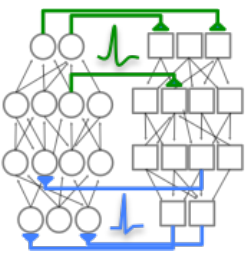Dr. Robert Legenstein
Full Professor
Institute Head
Institute of Theoretical Computer Science
Graz University of Technology
Speaker of the Graz Center for Machine Learning
Action Editor for TMLR
ADOPD
Adaptive Optical Dendrites
Funded by EU, FET-Open
Start: Oct. 2020
High speed, real time, low-energy computation is currently a major issue in our society with its vastly increasing data processing demands. Several of these properties are found in neural systems, but are not used for cognitive computing yet. For example, dendritic structures in cortical pyramidal neurons are characterized by rich linear as well as non-linear processing to combine their synaptic inputs into an output signal. This results in powerful computational properties that can realize different I/O transformations along different dendritic branches in parallel using little energy. Furthermore, these processes are adaptive due to synaptic plasticity. Conventional hardware (CPUs, GPUs, FPGAs, etc.) often avoids non-linear processing. The same holds for modern artificial neural networks (ANNs) that also make only limited use of this, mostly in their output transforms. However, the non-linear properties, that make dendritic processing highly efficient, have not yet been exploited. The goal of this project is to implement adaptive dendritic processing in photonic hardware by using optical fiber configurations, along with additional photonic elements. The exploitation of optical fiber systems will allow us to create novel types of highly efficient and ultra-fast computational elements (Optical Dendritic Units, ODUs).
Our role in the project: We investigate computation and learning in neuronal networks with nonlinear dendritic processing and develop learning algorithms for ODUs. We collaborate with experts for optical fiber systems to to guide implementatin of these systems.
Dr. Robert Legenstein
Institute of Theoretical Computer Science
Inffeldgasse 16b/I
8010 Graz
Austria
+43 / 316 873 5824
robert.legenstein@igi.tugraz.at

 Horizon 2020 FET-Proactive Project
Horizon 2020 FET-Proactive Project